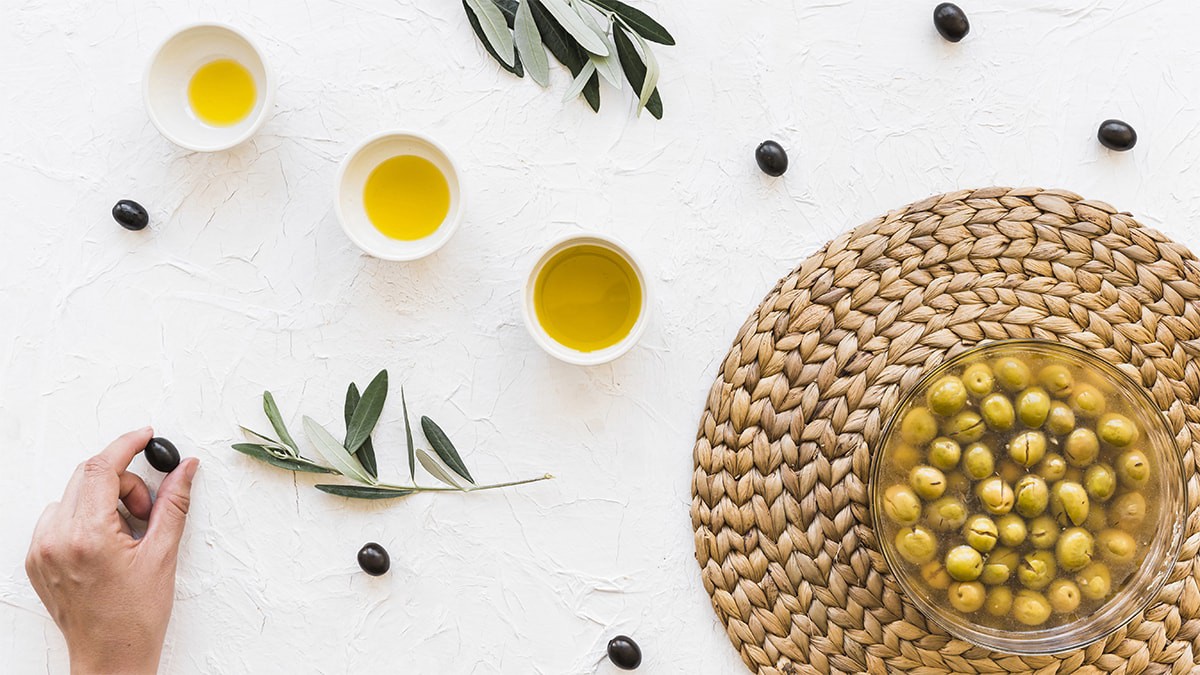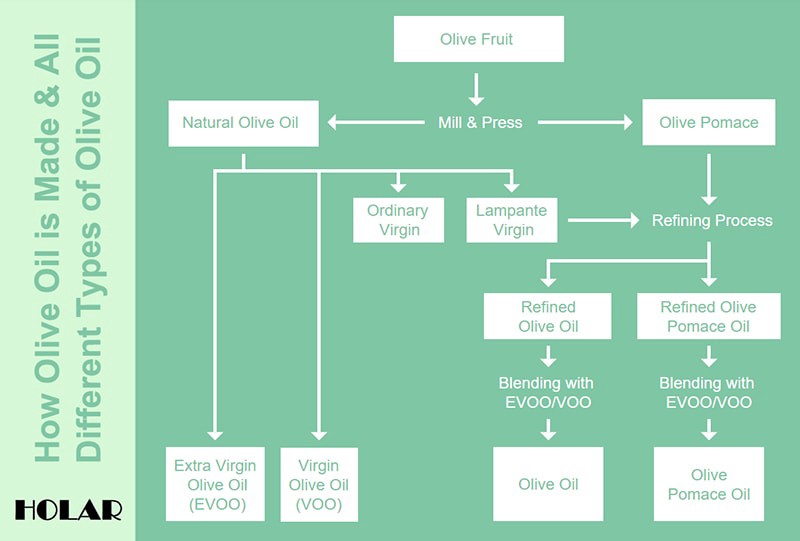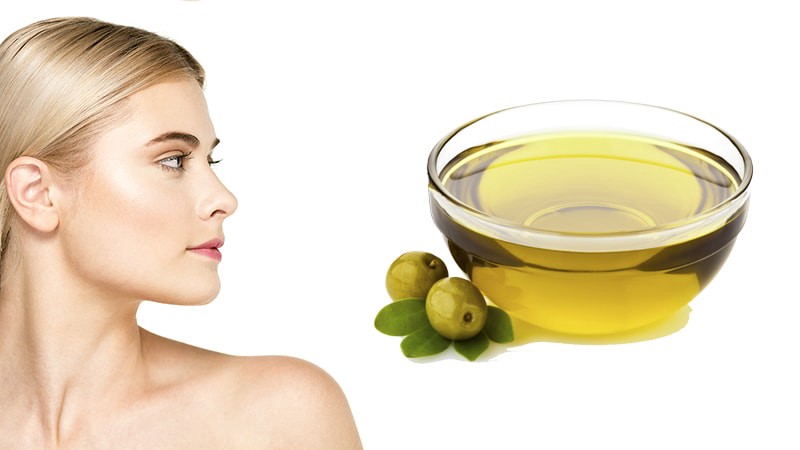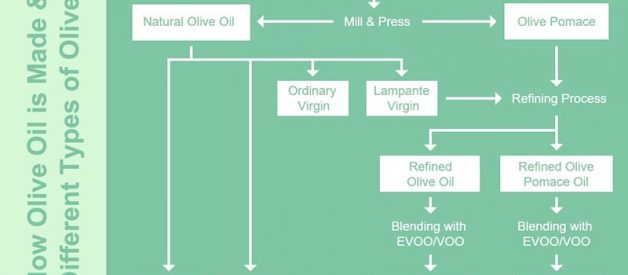Reference: https://www.holar.com.tw/blog/the-complete-guide-to-understanding-all-different-types-of-olive-oil/

Olive oil, just as the name implies, comes from olives, which are a fruit, not a veggie! They grow directly on the olive tree, in groves, in places like Spain and Italy and the south of France. These little gems are considered by many to be a ?superfood,? right up there with walnuts because they are so rich in nutrients. The olive is also rich in monounsaturated fat (MUFA) which is extremely healthy stuff. It?s also considered a better alternative for cooking and salad dressing than butter, or vegetable or canola oil, and consequently grocery store shelves are brimming with many different types of olive oil ? virgin, extra virgin, etc. Which one to use when you?re cooking can be a struggle to sort out, because some are better than others, and vary in price from reasonable to sky high!
And yet, not all olive oils are created equal, and you may find yourself bewildered by the price variations and the different labels. ?Why is this bottle ten dollars more than that one?? is a common refrain we hear in grocery stores. Sometimes, the differences are not made clear on the labels, depending on the country of origin and the producer. Many nations subscribe to the standards set by the International Olive Council (IOC), which has a United Nations (UN) charter that determines criteria for different olive oils, their quality, and pureness. It can still be confusing, however, but fear not! In this article, we explain how olive oil is made, the different types, and their characteristics. In no time, you?ll be an olive oil expert!
1) The Different Types of Olive Oils & How They Are Made
Olive oil is rated by how it?s made, the level of acidity, and of course its flavor. Once olives ripen on trees, they are harvested and, by hand, workers weed out olives of inferior quality. The olives are then pressed, and stored for a brief period. Then they are rinsed ? cold water only! ? and crushed and milled by an olive crusher; this is how natural olive oil is separated from the olive pomace.
Natural olive is then separated into the following categories using these different criteria:
- Extra Virgin Olive Oil: Virgin olive oil which has a free acidity, expressed as oleic acid, of not more than 0.8 grams per 100 grams, and the other characteristics of which correspond to those fixed for this category in this standard.
- Virgin Olive Oil: Virgin olive oil which has a free acidity, expressed as oleic acid, of not more than 2 grams per 100 grams and the other characteristics of which correspond to those fixed for this category in this standard.
- Ordinary Virgin Olive Oil: Virgin olive oil which has a free acidity, expressed as oleic acid, of not more than 3.3 grams per 100 grams and the other characteristics of which correspond to those fixed for this category in this standard.
- Lampante Virgin Olive Oil: Virgin olive oil which has a free acidity, expressed as oleic acid, of more than 3.3 grams per 100 grams and/or the organoleptic characteristics and other characteristics of which correspond to those fixed for this category in this standard. It is intended for refining or fechnical use.
Lampante virgin olive oil, and olive pomace, which is the solid residue left over from olive oil production ? during pressing and centrifugation, both are used as refining techniques ? use agents like alkalies, acids, and heat to remove as much oil as possible:
- Refined Olive Oil: Obtained from lampante virgin olive oil by refining methods which do not lead to alterations in the initial glyceridic structure. It has a free acidity, expressed as oleic acid, of not more than 0.3 grams per 100 grams and its other characteristics correspond to those fixed for this category in this standard.
- Refined Olive Pomace Oil: Obtained from crude olive pomace oil by refining methods which do not lead to alterations in the initial glyceridic structure. It has a free acidity, expressed as oleic acid, of not more than 0.3 grams per 100 grams and its other characteristics correspond to those fixed for this category in this standard.
The refined olive pomace oil and the refined olive oil blend with extra virgin olive oil (EVOO) or virgin olive oil (VOO) to become palatable for human consumption. These are simply called olive oil, and olive pomace oil.
- Olive Oil: The oil consisting of a blend of refined olive oil and virgin olive oils fit for consumption as they are. It has a free acidity, expressed as oleic acid, of not more than 1 gram per 100 grams and its other characteristics correspond to those fixed for this category in this standard.
- Olive Pomace Oil: The oil comprising the blend of refined olive pomace oil and virgin olive oils fit for consumption as they are. It has a free acidity of not more than 1 gram per 100 grams and its other characteristics correspond to those fixed for this category in this standard.

Now, let us take a deep look at those 4 types of olive oil we mostly see: extra virgin olive oil, virgin olive oil, olive oil, and olive pomace oil:
1) Extra Virgin Olive Oil (EVOO)
If you are seeking the most attributes associated with olive oil, the extra virgin olive oil (EVOO) is the best choice. It?s likely the best-known type of olive oil and is made by grinding olives into a paste, then removing the oil. There is no heat used making this; when you see ?cold-pressed? on a label, that?s what it means. This takes a lot of time and effort, which is why it is often pricier than other olive oils.
But it shouldn?t sit on your pantry shelf; researchers agree its health benefits are maximized when you use it while it?s fresh. You should use it within six months, and check the harvest date on the label. Purchase it within 12?18 months of that date so you get the most from its flavor and nutrients.
The color is sort of forest green, and it?s not like wine ? it doesn?t need to mature. Its flavor may be buttery and soft, or spicy and sharp; sometimes it?s even reminiscent of grass, citrus-like lemons, and pepper.
EVOO is thought to be the healthiest of all olive oils because it is so rich in the antioxidant called polyphenols, and that?s what lends EVOO its anti-inflammatory properties. Here?s what it needs to be a certified extra virgin:
- The product must come from the initial pressing of fresh olives, usually within one day of their harvest.
- The free, fatty acid level must be lower than 0.8 percent.
- The oil must be extracted organically, meaning by no mechanical process, and a heat level of fewer than 28 C.
- If the oil is at all strong smelling or bitter that indicates it contains oleocanthal.
Extra virgin is of the highest grade and is the best tasting most flavourful olive oil. But to keep its fresh flavor, you must store it away from light ? in a pantry, for example ? and away from heat and air. Keep the lid tight and well-sealed. EVOO often comes in stainless steel cans because they are perfect for its storage, as they don?t allow heat, oxygen or light to penetrate through to the oil.
2) Virgin Olive Oil (VOO)
Next to EVOO, this is the best type of olive oil to buy; it?s also unrefined, so no chemicals or heat has been used while extracting the oil. To meet IOC standards, it must have an acidity level of less than 2 percent and contain roughly 1.5 percent free acidity.
There is one difference between EVOO and VOO, and that is the slightly higher free acidity value. That means it has more calories than EVOO and a higher smoke point. Although its taste varies, it is usually milder than EVOO.
Any olive oil labeled ?virgin? has minor differences in aroma and taste and has to meet lower chemical expectations. Therefore, it?s less costly and has a good flavor and is ideal for frying and sauteing.
Both of these types have the same number of antioxidants, however, and are tested to ensure they meet IOC standards.
3) Olive Oil
Olive oil is a name given to indicate any blended oil comprised of olive oil and a different type of oil. It?s sometimes called ?pure olive oil?, ?classic olive oil?, ?regular olive oil? or even just ?olive oil.?
It can be made in many different ratios with other oils, including soybean, grape seed, and safflower oil. These oils, in particular, are mild tasting and lower in cost. The most popular blends usually contain just enough extra virgin olive oil to give it character and substance.
The most common blends are 50/50, 75/25, 80/20 and 90/10. Because a blended oil tastes milder and has a lighter color, it?s popular with chefs and food manufacturers. This is an all-purpose oil, popular because it has a higher smoke point and a less strong flavor than EVOO.
Olive oil is a great option if you?re preserving foods, like herbs and vegetables, in oil, as it allows the flavors of those foods to ?shine,? and the colors, too!
Olive oil has polyphenols in it, which are organic antioxidants, and it?s brimming with vitamins A, D, E, and K. You likely realize that taking vitamins is good for your body, but did you know that applying them directly is excellent for your scalp, skin, and hair? That?s right, and many people use olive oil directly on those areas to get the full benefit of vitamins, but also to tame frizzy, dry hair, and to soothe dry, itchy skin. You can even use it to get rid of dandruff!

4) Olive Oil Pomace
While extra-virgin olive oil is usually described as the ?first cold press,? what is called ?pomace oil? cannot even be described as ?second press.? Once the usual procedure is followed for extracting oil from olives, there is approximately 5?8 percent of the oil left in the pulp, or the ?pomace,? as it?s known.
Olive pomace is lower quality and grade than the other olive oils with which you are familiar, because of how it?s extracted and the chemicals used during that process. It?s still, technically, oil from olives, but because of the chemicals it must not be called, indirectly or directly, ?olive oil.?
And yet, pomace oil is used for deep frying, and it?s safe for human consumption. It even keeps some of the health benefits that ?usual? olive oil does. And pomace oil is definitely the smart alternative to some vegetable oils, like soybean and canola.
Conclusion
The next time you go shopping for olive oil, you?ll be armed with all the information outlined here. Most important are three ?takeaways?:
- Be sure the olive oil you choose adheres to IOC standards, because other ones are just not as good, nor are they necessary reliable. It may say it?s olive oil, but now you understand the different characteristics of different types and grades unique to each one. Ask yourself: ?what am I doing with this olive oil? Making salad dressing, deep frying chicken, or sauteing onions or other vegetables?? Once you determine that and read all the labels of the bottles or cans in front of you, you?ll know which olive oil is best for your kitchen adventure!
- Look for oils with free fatty acids, less than 10 meq/kg.
- Remember to keep olive oil away from light and heat sources. Using stainless steel olive oil cans to store it is the smartest choice. When you?re making salad dressing, use an attractive jar or bottle to mix in just enough oil for the recipe. That way it stays fresh even when it?s sitting on the dining room table, and it looks pretty, too! As they say in France, bon appetit!
![]()
About HOLAR
We are the kitchen and dining products expert supplier from Taiwan, and we specialize in supplying high-quality salt and pepper grinders, coffee grinders, canister sets, oil & vinegar, tabletop, snacks/spice servers, beverage dispensers, trash cans and over 600 kitchenware & houseware products.
Please let us quickly brief our advantages:- Over 50 years of manufacturing kitchen and dining products.- Long cooperate and own factories to control the highest quality.- Offer over 600 products for you to compete in any markets.- Products are made of strictly selected materials to maintain perfection.- 100% made in Taiwan to ensure highly competitive around the world. – Third-party certificate to deliver trustworthy quality products to you.
Welcome to visit https://www.holar.com.tw/ for more information about us and our product lines, or contact [email protected] and we are here to assist you anytime.


